-
Car Reviews
- All reviews
- Midsize SUVs
- Small cars
- Utes
- Small SUVs
- Large SUVs
- Large cars
- Sports SUVs
- Sports cars
- Vans
Latest reviews
- Car News
-
Car Comparisons
Latest comparisons
- Chasing Deals
Hyundai’s super-sleek, all-electric sedan will turn heads while delivering wild range. And the new Ioniq 6 is sizing up to be a solid Tesla 3 challenger
Ever meet a set of siblings who say they’re twins but really don’t look all that much alike? Sometimes it happens with cars, too. Take the Hyundai Ioniq 5 and its successor, the Ioniq 6. Other than the swoopy H on the nose you’d be forgiven for thinking these two cars come from different planets, never mind different manufacturers.
But they’re both Hyundais and they’re both built on the very same platform, the E-GMP skateboard battery pack with either one or two motors. The Ioniq 6 is numerically one more than the 5 but it sits in a completely different segment and, despite the shared hardware, goes a whopping 107km farther on a charge than its SUV sibling.
How does it do it? Extreme aerodynamics.
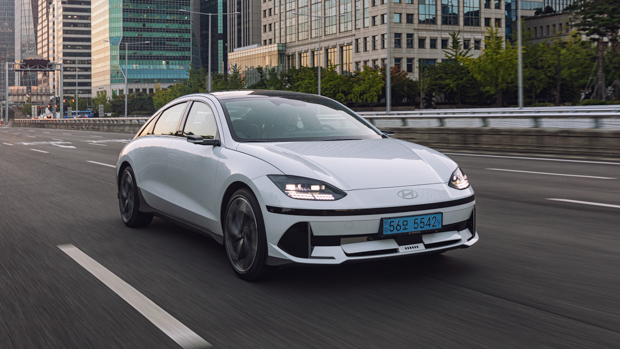
Take one look at the Ioniq 6 and it’s clear this is a car designed for a purpose. How else would you defend the too-low nose and a sweeping roofline that obliterates rear-seat headroom? The purpose here was aerodynamics and Hyundai’s latest is its sleekest yet.
The Ioniq 6 has a coefficient of drag of just 0.21, just a tick behind the most slippery production car on the planet, the Mercedes-Benz EQS (at 0.20) and matching some other long-legged EVs such as Tesla’s Model S and the Lucid Air.
That this is a Hyundai that will probably cost somewhere in the region of half as much as any of those alternatives makes it something of a crowning achievement.
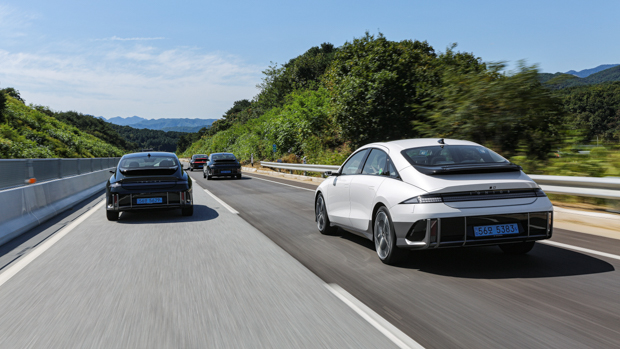
How did the brand achieve that? Well, naturally it starts at the nose, which as I mentioned above looks proportionally mismatched to the rest of the car. Integrated into the leading facia is a pair of flaps. When open, they provide cooling airflow over the car’s radiator. When the car doesn’t need the ventilation, they close to reduce drag.
More air is ducted through the bumper and around the front wheels, guided by a small protrusion integrated into the leading edge of the wheel well. This helps smooth the air over the side of the car, where it is pulled around and mixed with air coming over the top thanks to that rather pronounced spoiler.
Hyundai says that the wing’s shape was inspired by the Spitfire; yes the historic World War II fighter aircraft usually seen painted in olive drab. It’s certainly far more shapely than the wing on the 2020 Prophecy concept that predicted the Ioniq 6, but whether it’s better-looking I’ll leave to you to decide.
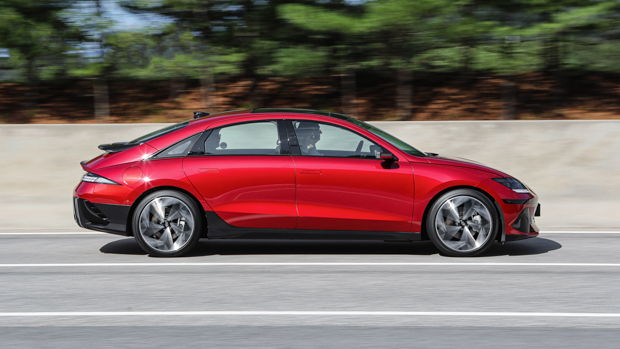
The back is far and away the most striking visual aspect of the outside of the car. A sweeping set of tail-lights runs in a slit cutting from one fender to the next, then below that, two pairs of vertical highlights run up and over the lower diffuser. It’s all a little busy, but I think it works.
Inside those lights is where you see the pixel motif at its extreme deployment, but the little squares are everywhere. Search and you’ll find them integrated into styling cues throughout, including those stalks that replace the rear-view mirrors.
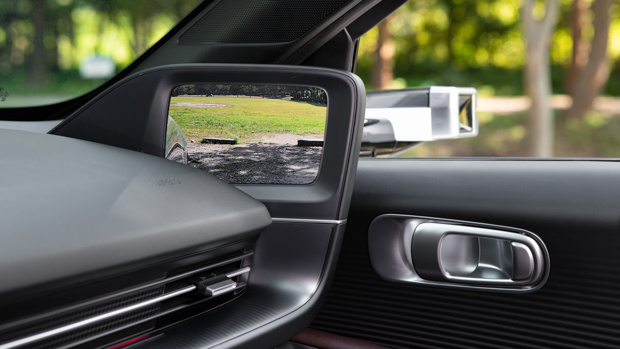
Yes, in search of aero the Ioniq 6 has ditched the traditional, reflective surface and instead gone for a pair of digital cameras. These beam images to a matching set of displays integrated into the sides of the dashboard.
That dash sweeps upward to provide the mirror displays a good home, but trust me when I say it’ll take a good few hours of driving before you retrain yourself to look at the displays rather than gazing out the window when changing lanes. Muscle-memory foibles aside, the displays work well enough, even in bright sunlight.
Those who are willing to forgo some aerodynamic efficiency for traditional mirrors should take comfort in that fact that Chasing Cars has previously spotted an Ioniq 6 prototype wearing the analogue option in Australia, suggesting that it will at least be offered locally as an option, if not as standard.
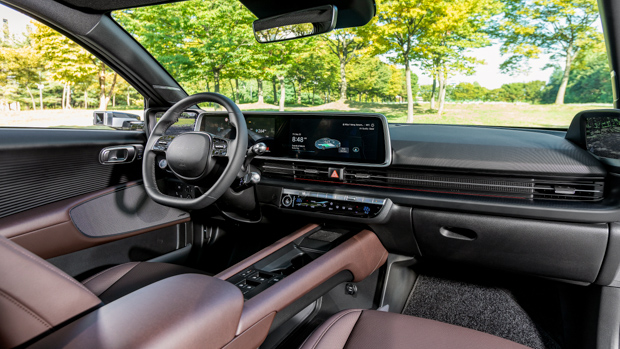
The rest of the interior is a lot less progressive and a lot more familiar. Well, if you’ve spent any time in the Ioniq 5, at least.
Here we have the same, dual, 12.3-inch displays situated side-by-side and standing proudly out of that sweeping dash. In the left-hand-drive configuration I drove, the right display serves infotainment duties, touch-sensitive and controlling everything from media to HVAC. The left display, meanwhile, serves as a gauge cluster, giving speed and range and navigation cues.
Hyundai’s familiar infotainment system calls the shots, with Android Auto and Apple CarPlay on tap as well if you want something a little more mobile. However, in South Korea, where I drove the Ioniq 6, you’ll want to stick with the integrated nav. Neither Google nor Apple Maps is of much use there thanks to some strict laws about exporting mapping data from the country.

Again like the Ioniq 5, the 6’s shifter is mounted high next to the steering wheel, a chrome protrusion you simply twist in the direction you want to go: forward for D and backwards for R. Shift paddles control regen and yes, there’s a full one-pedal driving mode available here.
Mounting the shifter up high frees up all sorts of room in the center console. Where the Ioniq 5 has a little cubby between seats you can shuttle forward or back, the sedan has a more traditional divider, not unlike what you’d find from a transmission tunnel. However, since there are no actual mechanical bits inside there, Hyundai hollowed it out, creating a massive cubby.
Materials are a little hit or miss, with some hard plastics readily found, but both driver and passenger have comfortable, reasonably supportive seats with power adjustment. Out back, however, is where the compromises were made. While the seats there are plenty comfy and there’s about three hectares worth of footroom, the headroom is decidedly lacking. An executive shuttle this ain’t.
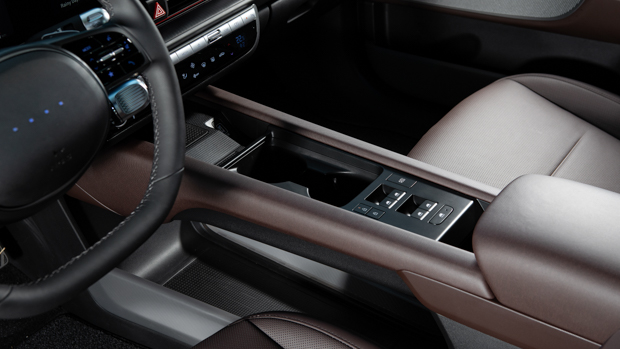
That’s a bit of a shame as the Ioniq 6 is comfortable enough to be one. While Korea’s roads aren’t the best for driving or exploring, nor for testing the handling limits of a machine, a few hours behind the wheel was plenty enough to convince me that the Ioniq 6 has lost none of the luxurious poise of its SUV sibling.
I drove a top-trim, all-wheel-drive model with the optional 20-inch wheels, but despite the slim sidewalls the car soaked up concrete separation joints and other asphalt imperfections without complaint. Handling felt a bit on the soft side and the steering is hardly quick, but this isn’t meant to be a sports car by any means.
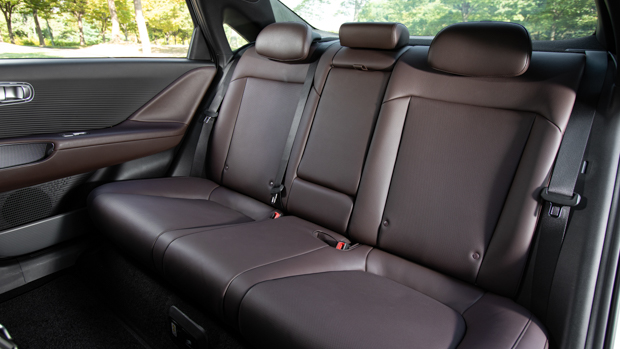
That doesn’t mean it isn’t rapid enough to be one. With 239kW and 605Nm delivered by two motors to all four wheels, the Ioniq 6 is quick. Seriously quick. However, those wanting maximum range, or simply to save a few dollars, will want to opt for the rear-wheel-drive model. It’s that one, with the 18-inch wheels, that delivered a whopping 614km on the WLTP cycle. Again, that’s 107km farther than the Ioniq 5.
Despite the 6’s aerodynamic advantage, the motors, battery pack and all the related plumbing are identical between the two cars. That’s a bit sad for me, as I’d take the more practical 5 over the shapely 6 from a pure utility standpoint. But anyone looking to maximize range, and therefore efficiency, will clearly want the sedan.
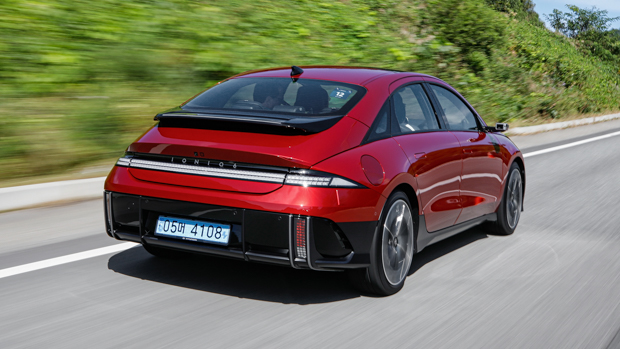
Pricing and specific availability on the Ioniq 6 is still a bit of a mystery but, given the shared hardware, don’t expect it to be miles away from the price on the Ioniq 5. (For reference, the AWD Extended Range Ioniq 5 we reviewed last year cost $75,900).
That is to say, it should be priced right, potentially making it yet another strong contender in an increasingly competitive EV segment from Hyundai.
About Chasing cars
Chasing Cars reviews are 100% independent.
Because we are powered by Budget Direct Insurance, we don’t receive advertising or sales revenue from car manufacturers.
We’re truly independent – giving you Australia’s best car reviews.
The estimate provided does not take into account your personal circumstances but is intended to give a general indication of the cost of insurance, in order to obtain a complete quote, please visit www.budgetdirect.com.au. Estimate includes 15%^ online discount.
^Conditions Apply
Budget Direct Insurance arranged by Auto & General Services Pty Ltd ACN 003 617 909(AGS) AFSL 241 411, for and on behalf of the insurer, Auto & General Insurance Company Limited(ABN 42 111 586 353, AFSL 285 571).Because we don’t know your financial needs, we can’t advise you if this insurance will suit you. You should consider your needs and the Product Disclosure Statement before making a decision to buy insurance. Terms and conditions apply.
Indicative quote based on assumptions including postcode , 40 year old male with no offences, licence suspensions or claims in the last 5 years, a NCD Rating 1 and no younger drivers listed. White car, driven up to 10,000kms a year, unfinanced, with no modifications, factory options and/or non-standard accessories, private use only and garaged at night.
^Online Discounts Terms & Conditions
1. Discounts apply to the premium paid for a new Budget Direct Gold Comprehensive Car Insurance, Third Party Property Only or Third Party Property, Fire & Theft Insurance policy initiated online on or after 29 March 2017. Discounts do not apply to optional Roadside Assistance.
2. Discounts do not apply to any renewal offer of insurance.
3. Discounts only apply to the insurance portion of the premium. Discounts are applied before government charges, taxes, levies and fees, including instalment processing fees (as applicable). The full extent of discounts may therefore be impacted.
4. We reserve the right to change the offer without notice.